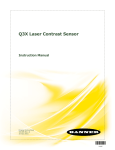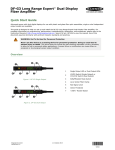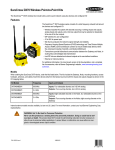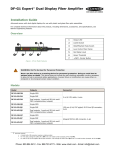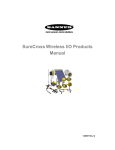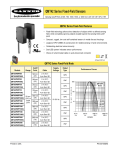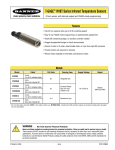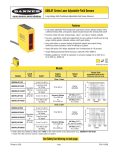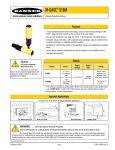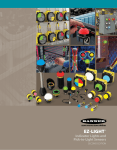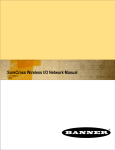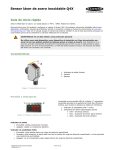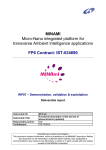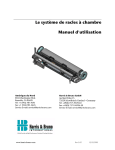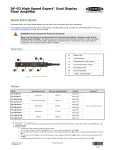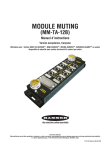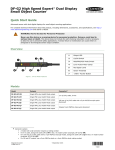Download Banner Q4X Series Stainless Steel Laser Sensors Instruction Manual
Transcript
Q4X Stainless Steel Laser Sensor Instruction Manual Original Instructions 181483 Rev. E 9 March 2015 Phone: 800.894.0412 - Fax: 888.723.4773 - Web: www.clrwtr.com - Email: [email protected] Q4X Stainless Steel Laser Sensor Contents 1 Product Description ........................................................................................................ 3 ....................................................................................................................................3 1.1 Models 1.2 Overview ................................................................................................................................ 3 1.3 Features ................................................................................................................................. 4 1.3.1 Display and Indicators ......................................................................................................4 1.3.2 Buttons ......................................................................................................................... 4 1.4 Laser Description and Safety Information .................................................................................... 5 2 Installation 2.1 2.2 2.3 2.4 2.5 ..................................................................................................................... 6 Install the Safety Label ............................................................................................................. 6 Sensor Orientation ................................................................................................................... 6 Sensor Mounting ...................................................................................................................... 7 Wiring Diagram ........................................................................................................................7 Cleaning and Maintenance .........................................................................................................7 3 Sensor Programming ..................................................................................................... 8 3.1 Light Operate/Dark Operate ...................................................................................................... 8 3.2 Setup Mode .............................................................................................................................8 3.2.1 TEACH Menu ................................................................................................................ 10 3.2.2 Response Speed ........................................................................................................... 10 3.2.3 Output Timing Delays ....................................................................................................10 3.2.4 Zero Reference Location ................................................................................................ 11 3.2.5 Shift the Zero Reference Location after a TEACH ............................................................... 12 3.2.6 Input Wire Function ...................................................................................................... 12 3.2.7 Display View ................................................................................................................ 12 3.2.8 Exit Setup Mode ........................................................................................................... 12 3.2.9 Reset to Factory Defaults ...............................................................................................12 3.3 Manual Adjustments ............................................................................................................... 13 3.4 Remote Input ......................................................................................................................... 13 3.4.1 Select the TEACH Mode Using the Remote Input ............................................................... 14 3.4.2 Reset to Factory Defaults Using the Remote Input .............................................................15 3.5 Locking and Unlocking the Sensor Buttons .................................................................................. 15 3.6 TEACH Procedures .................................................................................................................. 15 3.6.1 Two-Point Static Background Suppression TEACH ..............................................................15 3.6.2 Dynamic Background Suppression TEACH ........................................................................ 17 3.6.3 One-Point Window (Foreground Suppression) ................................................................... 18 3.6.4 One-Point Background Suppression ................................................................................. 20 3.7 Sync Master/Slave ..................................................................................................................21 4 Specifications .............................................................................................................. 22 4.1 Dimensions ........................................................................................................................... 23 4.2 Performance Curves ............................................................................................................... 23 5 Abbreviations .............................................................................................................. 24 6 Troubleshooting ...........................................................................................................26 7 Accessories ...................................................................................................................27 7.1 Cordsets ............................................................................................................................... 27 7.2 Brackets ............................................................................................................................... 28 7.3 Aperture Kits ......................................................................................................................... 28 8 Contact Us ................................................................................................................... 29 9 Banner Engineering Corp Limited Warranty ................................................................. 30 Phone: 800.894.0412 - Fax: 888.723.4773 - Web: www.clrwtr.com - Email: [email protected] Q4X Stainless Steel Laser Sensor 1 Product Description Class 1 laser CMOS sensor with a bipolar (1 PNP & 1 NPN) output. Patent pending. • • • • • • • • • • The ultimate problem solver: reduce sensor inventory with a reliable, durable sensor that solves the most challenging applications Solves difficult distance‐based applications regardless of target surface reflectivity, including black foam on black plastic, black rubber in front of metal, multicolor packaging and targets of all colors Reliable sensing range of 25 mm (0.98 in) to 300 mm (11.81 in) with best in class excess gain Angled four‐digit display with submillimeter resolution is easily viewed from multiple vantage points Display provides clear user feedback for easy setup, and bright output indicator provides high visibility of sensor operation Intuitive setup utilizing three tactile buttons conveniently located below the display Durable and robust construction resists mechanical impact, over tightening and extreme vibration FDA grade stainless steel, chemically‐resistant material and laser marked sensor information withstands aggressive cleaning procedures Superior resistance to ambient light interference prevents nuisance output trips under changing lighting conditions Temperature-compensated design ensures reliable detection during changing temperature conditions WARNING: Not To Be Used for Personnel Protection Never use this device as a sensing device for personnel protection. Doing so could lead to serious injury or death. This device does not include the self-checking redundant circuitry necessary to allow its use in personnel safety applications. A sensor failure or malfunction can cause either an energized or de-energized sensor output condition. 1.1 Models Model Sensing Range Output Cable Q4XTBLAF300-Q8 25 mm (0.98 in) to 300 mm (11.81 in) Bipolar: 1 NPN; 1 PNP 5-pin Euro M12 Integral Connector 1.2 Overview The Q4X Sensor is a Class 1 laser CMOS sensor with a bipolar output. The normal sensor state is Run mode. From Run mode, the switch point value and LO/DO selection can be changed and the selected TEACH method can be performed. The secondary sensor state is Setup mode. From Setup mode, the TEACH mode can be selected, all standard operating parameters can be adjusted, and a factory reset can be done. Phone: 800.894.0412 - Fax: 888.723.4773 - Web: www.clrwtr.com - Email: [email protected] Q4X Stainless Steel Laser Sensor 1.3 Features 1 2 3 1. Output Indicator (Amber) 2. Display 3. Buttons Figure 1. Sensor Features 1.3.1 Display and Indicators 1 2 Figure 2. Display in Run Mode The display is a 4-digit, 7-segment LED. The main screen is the Run Mode screen, which shows the current distance to the target in millimeters. 1. Stability Indicator (STB = Green) 2. Active TEACH Indicators • DYN = Dynamic (Amber) • FGS = Foreground Suppression (Amber) • BGS = Background Suppression (Amber) Output Indicator • • On—Outputs conducting (closed) Off—Outputs not conducting (open) Stability Indicator (STB) • • • On—Stable signal within the specified sensing range Flashing—Marginal signal, the target is outside the limits of the specified sensing range, or a multiple peak condition exists Off—No target detected within the specified sensing range Active TEACH Indicators (DYN, FGS, and BGS) • • • • DYN, FGS, and BGS all off = Two-point TEACH mode selected (default) DYN on = Dynamic TEACH mode selected FGS on = Foreground suppression TEACH mode selected BGS on = Background suppression TEACH mode selected 1.3.2 Buttons Use the sensor buttons (SELECT)(TEACH), (+)(LO/DO), and (-)(MODE) to program the sensor. Phone: 800.894.0412 - Fax: 888.723.4773 - Web: www.clrwtr.com - Email: [email protected] Q4X Stainless Steel Laser Sensor (SELECT)(TEACH) • Press to select menu items in Setup mode • Press and hold for longer than 2 seconds to start the currently selected TEACH mode (the default is two-point TEACH) (+)(LO/DO) • Press to navigate the sensor menu in Setup mode • Press to change setting values; press and hold to increase numeric values • Press and hold for longer than 2 seconds to switch between light operate (LO) and dark operate (DO) (-)(MODE) • Press to navigate the sensor menu in Setup mode • Press to change setting values; press and hold to decrease numeric values • Press and hold for longer than 2 seconds to enter Setup mode NOTE: When navigating the menu, the menu items loop. 1.4 Laser Description and Safety Information CAUTION: Use of controls or adjustments or performance of procedures other than those specified herein may result in hazardous radiation exposure. Do not attempt to disassemble this sensor for repair. A defective unit must be returned to the manufacturer. Class 1 Lasers Class 1 lasers are lasers that are safe under reasonably foreseeable conditions of operation, including the use of optical instruments for intrabeam viewing. Laser wavelength: 655 nm Output: < 0.20 mW Pulse Duration: 7 µs to 2 ms Phone: 800.894.0412 - Fax: 888.723.4773 - Web: www.clrwtr.com - Email: [email protected] Q4X Stainless Steel Laser Sensor 2 Installation CLASS 1 LASER PRODUCT The safety label must be installed on Q4X sensors that are used in the United States. NOTE: Position the label on the cable in a location that has minimal chemical exposure. 1. Remove the protective cover from the adhesive on the label. 2. Wrap the label around the Q4X cable, as shown. 3. Press the two halves of the label together. COMPLIES WITH IEC 60825-1:2007 2.1 Install the Safety Label COMPLIES WITH 21 CFR 1040.10 AND 1040.11 EXCEPT FOR DEVIATIONS PURSUANT TO LASER NOTICE No. 50, DATED JUNE 24, 2007. BANNER ENGINEERING CORP. 9714 10TH AVENUE NORTH MINNEAPOLIS, MN 55441 CLASS 1 LASER PRODUCT COMPLIES WITH IEC 60825-1:2007 Figure 3. Safety Label Installation 2.2 Sensor Orientation Optimize detection reliability and minimum object separation performance with correct sensor-to-target orientation. To ensure reliable detection, orient the sensor as shown in relation to the target to be detected. Figure 4. Optimal Orientation of Target to Sensor See the following figures for examples of correct and incorrect sensor-to-target orientation as certain placements may pose problems for sensing some targets. The Q4X can be used in the less preferred orientation and provide reliable detection performance; see Figure 16 on page 23 for the minimum object separation distance required for each case. Correct Incorrect Figure 5. Orientation by a wall Correct Incorrect Figure 6. Orientation for a turning object (Optimal) Correct Incorrect Figure 7. Orientation for a height difference Horizontal Orientation Vertical Orientation Figure 8. Orientation for a color or luster difference Phone: 800.894.0412 - Fax: 888.723.4773 - Web: www.clrwtr.com - Email: [email protected] Q4X Stainless Steel Laser Sensor 2.3 Sensor Mounting 1. If a bracket is needed, mount the sensor onto the bracket. 2. Mount the sensor (or the sensor and the bracket) to the machine or equipment at the desired location. Do not tighten at this time. 3. Check the sensor alignment. 4. Tighten the screws to secure the sensor (or the sensor and the bracket) in the aligned position. 2.4 Wiring Diagram 1 + 10-30V dc – 3 2 4 5 1 2 4 5 3 Load Load Key Remote Teach NOTE: Open lead wires must be connected to a terminal block. 1 2 3 4 5 = = = = = Brown White Blue Black Gray NOTE: The input wire function is user-selectable. The default for the input wire function is off (disabled). 2.5 Cleaning and Maintenance Handle the sensor with care during installation and operation. Sensor windows soiled by fingerprints, dust, water, oil, etc. may create stray light that may degrade the peak performance of the sensor. Blow the window clear using filtered, compressed air, then clean as necessary using water and a lint-free cloth. Phone: 800.894.0412 - Fax: 888.723.4773 - Web: www.clrwtr.com - Email: [email protected] Q4X Stainless Steel Laser Sensor 3 Sensor Programming Program the sensor using the buttons on the sensor or the remote input (limited programming options). In addition to programming the sensor, use the remote input to disable the buttons for security, preventing unauthorized or accidental programming changes. See Locking and Unlocking the Sensor Buttons on page 15 for more information. 3.1 Light Operate/Dark Operate The default output configuration is light operate. To switch between light operate and dark operate, use the following instructions: 1. Press and hold LO/DO for longer than 2 seconds. The current selection displays. 2. Press LO/DO again. The new selection flashes slowly. 3. Press SELECT to change the output configuration and return to Run mode. NOTE: If neither SELECT nor LO/DO are pressed after step 2, the new selection flashes slowly for a few seconds, then flashes quickly and the sensor automatically changes the output configuration and returns to Run mode. 3.2 Setup Mode Access Setup mode and the sensor menu from Run mode by pressing and holding MODE for longer than 2 seconds. Use and to navigate through the menu. Press SELECT to select a menu option and access the submenus. Use and to navigate through the submenus. Press SELECT to select a submenu option and return to the top menu, or press and hold SELECT for longer than 2 seconds to select a submenu option and return immediately to Run mode. To exit Setup mode and return to Run mode, navigate to and press SELECT. Phone: 800.894.0412 - Fax: 888.723.4773 - Web: www.clrwtr.com - Email: [email protected] Q4X Stainless Steel Laser Sensor Top Menu Sub Menus Teach Process Selection Response Speed Gain and Sensitivity* two-point static BGS dynamic BGS one-point Window (FGS) one-point BGS ( default setting) set Response Speed to 1.5 ms set Response Speed to 3 ms set Response Speed to 10 ms set Response Speed to 25 ms set Response Speed to 50 ms high excess gain mode standard excess gain with increased noise immunity Gain menu is available when Response Speed is set to 10, 25 or 50 ms Output Timing Delays off: no delays enabled enable on and/or off delay (set value in Delay Timer menu) 1 Shot, fixed output pulse duration LO = On pulse when a target is detected inside of the switch point(s) DO = On pulse when a target is detected outside of the switch point(s) Delay Timer Available when selected ms to Available when selected when is selected,1 to 9 ms is range available when Response Speed is set to 1.5 or 3 ms sec range, set Delay Timer value (seconds have decimal) Select Zero Reference Location near: set zero displayed value to end of 18 mm barrel far: set zero displayed value to maximum detection range Shift Zero Reference after Teach Input Wire Function Display Read Exit Setup on: move the zero point after each teach off: zero point is either at end of barrel or maximum detection range off: remote teach input is not active set: Remote Teach input laser off when pulled low master slave display on display on, inverted display off (enters sleep mode after 60 seconds) display off, inverted (enters sleep mode after 60 seconds) end: select to exit setup Reset to Factory Defaults no: do not reset to factory defaults yes: reset to factory defaults Figure 9. Sensor Menu Map Phone: 800.894.0412 - Fax: 888.723.4773 - Web: www.clrwtr.com - Email: [email protected] Q4X Stainless Steel Laser Sensor 3.2.1 TEACH Menu Use this menu to select the TEACH mode. The default is two-point TEACH. • —Two-point static background suppression • —Dynamic background suppression • —One-point window (foreground suppression) • —One-point background suppression After the TEACH mode is selected, from Run mode, press and hold TEACH for longer than 2 seconds to start the TEACH mode and program the sensor. See TEACH Procedures on page 15 for additional information and remote input TEACH instructions. 3.2.2 Response Speed Use this menu to select the response speed. The default is 10 milliseconds. • —1.5 milliseconds • —3 milliseconds • —10 milliseconds • —25 milliseconds • —50 milliseconds Table 1: Tradeoffs Response Speed Response Speed in Sync Mode Repeatability Ambient Light Rejection 1.5 ms 3 ms 500 µs Disabled 3 ms 6 ms 500 µs Enabled 10 ms 20 ms 2 ms Enabled 25 ms 50 ms 5 ms Enabled 50 ms 100 ms 10 ms Enabled Excess Gain See Table 7 on page 22 Gain and Sensitivity Use this menu to set the excess gain mode. This menu is only available when a 10, 25, or 50 millisecond response speed is selected. It is not available for 1.5 or 3 millisecond response speeds. • —High excess gain mode • —Standard excess gain mode with increased noise immunity 3.2.3 Output Timing Delays Use this menu to select the output timing delay to be set. On and off delay timers can be used together. The default is no delay. • —No delay • —Delay—enables the selection of on and off delay timers • —One-shot—enables a one-shot, fixed output pulse duration Phone: 800.894.0412 - Fax: 888.723.4773 - Web: www.clrwtr.com - Email: [email protected] Q4X Stainless Steel Laser Sensor ON Output OFF D OFF Delay D ON Delay D D 1-Shot D D Time (D = 1 - 9999 ms) Figure 10. Output Timing Delays When either set the timer(s): or is chosen, the sensor returns to the Setup menu and additional options become available to • —On delay • —Off delay • —One-shot delay timer NOTE: For the one-shot delay timer: • LO = On pulse when a target is detected inside of the switch point(s) • DO = On pulse when a target is detected outside of the switch point(s) Delay Timers , , Use these menus to set the delay timers. These menus are available only if an output timing delay is selected. For and , the default is 0. For , the default is 10 milliseconds for 10, 25, and 50 millisecond response speeds and 1 millisecond for 1.5 and 3 milliseconds response speeds. Use and to scroll through the values. Values greater than 10 increase or decrease by increments of 10. Millisecond values do not include the decimal point; seconds values include the decimal point. • • • • 1 to 9 ms (when 10 to 90 ms 100 to 900 ms 1.0 to 90.0 s is selected, the 1 to 9 ms range is available for 1.5 and 3 ms response times) 3.2.4 Zero Reference Location Use this menu to select the zero reference location. The default is , 0 = the end of the sensor barrel. • —0 = the end of the sensor barrel; the measurement increases further from the sensor • —0 = maximum range; the measurement increases closer to the sensor Phone: 800.894.0412 - Fax: 888.723.4773 - Web: www.clrwtr.com - Email: [email protected] Q4X Stainless Steel Laser Sensor 3.2.5 Shift the Zero Reference Location after a TEACH Use this menu to select whether the sensor shifts the zero reference location to the last taught distance. The default is , 0 = the end of barrel or the maximum range. • —Shift the zero reference location to one of the taught positions with each TEACH • —0 = the end of barrel or the maximum range, depending on the setting 3.2.6 Input Wire Function Use this menu to select the input wire function. The default is off, ignore all remote input pulses. • —Ignore all remote input pulses • —Remote TEACH input • —Laser off when pulled low • —Master sync line output for two-sensor cross-talk avoidance • —Slave sync line input for two-sensor cross-talk avoidance To configure sensors for master-slave operation, see Sync Master/Slave on page 21. 3.2.7 Display View Use this menu to select the display view. The default is right-reading. • —Right-reading • —Inverted • —Right-reading and the display enters sleep mode after 60 seconds • —Inverted and the display enters sleep mode after 60 seconds When the sensor is in sleep mode, the display wakes with the first button press. 3.2.8 Exit Setup Mode Navigate to and press SELECT to exit Setup mode and return to Run mode. 3.2.9 Reset to Factory Defaults Use this menu to restore the sensor to the factory default settings. See Factory Default Settings on page 12. Select to return to the sensor menu without restoring the defaults. Select return to Run mode. to apply the factory defaults and Factory Default Settings Setting Display view ( Factory Default ) Gain and sensitivity ( Input wire function ( —Right-reading, no sleep mode ) ) —High excess gain mode —Ignore all remote input pulses If the sensor was reset using the remote input, the sensor remains in Output configuration mode to allow use of the remote input. LO—Light Operate Phone: 800.894.0412 - Fax: 888.723.4773 - Web: www.clrwtr.com - Email: [email protected] Q4X Stainless Steel Laser Sensor Setting Factory Default Output timing delays ( Response speed ( ) —No delay 10 ms ) Shift the Zero Reference Location after a TEACH ( TEACH process selection ( Zero reference location ( ) ) —0 = the end of barrel —Two-point TEACH ) —Measurement increases further from sensor 3.3 Manual Adjustments Manually adjust the sensor switch point using the 1. From Run mode, press either or and buttons. one time. The current switch point value flashes slowly. to move the switch point up or to move the switch point down. After 1 second of inactivity, the new 2. Press switch point value flashes rapidly, the new setting is accepted, and the sensor returns to Run mode. NOTE: When FGS mode is selected (the FGS indicator is on), manual adjustment moves both sides of the symmetrical threshold window simultaneously, expanding and collapsing the window size. Manual adjustment does not move the center point of the window. 3.4 Remote Input Use the remote input to program the sensor remotely. The remote input provides limited programming options and is Active Low. For Active Low, connect the gray input wire to ground (0 V dc), with a remote switch connected between the wire and ground. Pulse the remote input according to the diagram and the instructions provided in this manual. The length of the individual programming pulses is equal to the value T: 0.04 seconds ≤ T ≤ 0.8 seconds. Exit remote programming modes by setting the remote input low for longer than 2 seconds. Phone: 800.894.0412 - Fax: 888.723.4773 - Web: www.clrwtr.com - Email: [email protected] Q4X Stainless Steel Laser Sensor Remote Input Input = Set Gray wire is remote teach input Pulse Timing (T) 0.04 seconds < T < 0.8 seconds Timing between Pulse groups > 1 second Starts selected Teach (same function as pressing Teach Button for > 2 sec) 1x Second pulse completes Teach (Two-point and Dynamic Teach only) 1x Teach Selection 2x 3x Two-point static background suppression Dynamic background suppression One-point window (foreground suppression) 4x One-point background suppression 1x 2x Button Lock 4x 1x Button Unlock (uloc) 2x Button Lock (loc) Reset to Factory Defaults (maintain remote input = SET) 8x Figure 11. Remote Input Map 3.4.1 Select the TEACH Mode Using the Remote Input 1. Access the TEACH selection. Action Result T Double-pulse the remote input. T displays. T 2. Select the desired TEACH mode. Action Result Pulses 1 2 3 4 TEACH Mode T Two-point static background suppression T T Dynamic background suppression T T T T T T T T One-point window (foreground suppression) T T T T T The selected TEACH method displays for a few seconds and the sensor returns to Run mode. One-point background suppression Phone: 800.894.0412 - Fax: 888.723.4773 - Web: www.clrwtr.com - Email: [email protected] Q4X Stainless Steel Laser Sensor 3.4.2 Reset to Factory Defaults Using the Remote Input Eight-pulse the remote input to apply the factory defaults and return to Run mode. T T T T T T T T T T T T T T T NOTE: The input wire function remains at remote teach input ( ). 3.5 Locking and Unlocking the Sensor Buttons Use the lock and unlock feature to prevent unauthorized or accidental programming changes. When locked, displays when the (SELECT)(TEACH) button is pressed. The switch point displays when (+)(LO/DO) or (-)(MODE) are pressed, but displays if the buttons are pressed and held. Button Instructions To lock or unlock the sensor using the buttons, press and hold depending on the previous status. and press four times. or flashes, Remote Input Instructions 1. Access the remote input. Action Result Four-pulse the remote input. T T T T T T T The sensor is ready to have the button state defined and displays. 2. Lock or unlock the sensor buttons. Action Result Single-pulse the remote input to unlock the sensor. Double-pulse the remote input to lock the sensor. T displays and the sensor returns to Run mode. T T T displays and the sensor returns to Run mode. 3.6 TEACH Procedures Use the following procedures to teach the sensor. To cancel a TEACH procedure, press TEACH for longer than 2 seconds, or hold the remote input low for longer than 2 seconds. momentarily displays when a TEACH procedure is canceled. 3.6.1 Two-Point Static Background Suppression TEACH Two-point TEACH sets a single switch point. The sensor sets the switch point between two taught target distances, relative to the shifted origin location. Phone: 800.894.0412 - Fax: 888.723.4773 - Web: www.clrwtr.com - Email: [email protected] Q4X Stainless Steel Laser Sensor 5 3 2 Press and Hold > 2s Press again Press again Switch Point Value 1 4 Figure 12. Two-Point Static Background Suppression (Light Operate shown) NOTE: The sensor must be set to = to use the following instructions. NOTE: To program the sensor using remote input, remote input must be enabled ( = ). 1. Present the target. Method Action Result Push Button Present the first target. The sensor-to-target distance must be within the sensor's range. The target's measurement value displays. Remote Input 2. Start the TEACH mode. Method Action Result Push Button Press and hold TEACH for longer than 2 seconds. and flash alternately on the display. The DYN, FGS, and BGS indicators flash. Remote Input No action required. N/A 3. Teach the sensor. Method Action Result Push Button Press TEACH to teach the target. The sensor is taught the first target. Remote Input Single-pulse the remote input. T , , and the current distance measurement flash alternately on the display. The DYN, FGS, and BGS indicators flash. 4. Present the target. Method Action Result Present the second target. The sensor-to-target distance must be within the sensor's range. , , and the distance measurement flash alternately on the display. The DYN, FGS, and BGS indicators flash. Push Button Remote Input 5. Teach the sensor. Method Action Push Button Press TEACH to teach the target. Remote Input Single-pulse the remote input. Result T The new switch point flashes rapidly and the sensor returns to Run mode. Phone: 800.894.0412 - Fax: 888.723.4773 - Web: www.clrwtr.com - Email: [email protected] Q4X Stainless Steel Laser Sensor Table 2: Expected TEACH Behavior for Two-Point Static Background Suppression See Figure 16 on page 23 for the minimum object separation. Condition TEACH Result Display Two valid distances that are greater than or equal to the horizontal minimum object separation Sets a switch point between the two taught distances The switch point distance flashes on the display Two valid distances that are less than the horizontal minimum object separation Sets a switch point in front of the furthest taught distance by the horizontal minimum object separation and the switch point distance flash alternately on the display One valid distance with one invalid TEACH point Sets a switch point between the one taught distance and 300 mm Two invalid TEACH points Sets a switch point at 290 mm and the switch point distance flash alternately on the display and the switch point distance flash alternately on the display 3.6.2 Dynamic Background Suppression TEACH Dynamic TEACH sets a single switch point during machine run conditions. Dynamic TEACH is recommended for applications where a machine or process may not be stopped for teaching. The sensor takes multiple samples and the switch point is set between the minimum and the maximum sampled distances. 3 2 Press and Hold > 2s 5 Press to start sampling Press to stop sampling Switch Point Value 4 1 Figure 13. Dynamic Background Suppression NOTE: The sensor must be set to = is amber to indicate Dynamic TEACH mode. to use the following instructions. The DYN indicator NOTE: To program the sensor using remote input, remote input must be enabled ( = ). 1. Present the target. Method Action Result Push Button Present the first target. The sensor-to-target distance must be within the sensor's range. The target's measurement value displays. Remote Input 2. Start the TEACH mode. Method Action Result Push Button Press and hold TEACH for longer than 2 seconds. and flash alternately on the display. The DYN indicator flashes. Phone: 800.894.0412 - Fax: 888.723.4773 - Web: www.clrwtr.com - Email: [email protected] Q4X Stainless Steel Laser Sensor Method Action Result Remote Input No action required. N/A 3. Teach the sensor. Method Action Result Push Button Press TEACH to teach the target. The sensor begins sampling target Remote Input Single-pulse the remote input. T distance information and and flash alternately on the display. The DYN indicator flashes. 4. Present the targets. Method Action Result Push Button Remote Input Present additional targets. The sensor-to-target distance must be within the sensor's range. The sensor continues to sample target distance information and and flash alternately on the display. The DYN indicator flashes. 5. Teach the sensor. Method Action Result Push Button Press TEACH to stop teaching the sensor. Remote Input Single-pulse the remote input. T The new switch point flashes rapidly and the sensor returns to Run mode. Table 3: Expected TEACH Behavior for Dynamic Background Suppression See Figure 16 on page 23 for the minimum object separation. Condition TEACH Result Display Two valid distances that are greater than or equal to the horizontal minimum object separation Sets a switch point between the two taught distances The switch point distance flashes on the display Two valid distances that are less than the horizontal minimum object separation Sets a switch point in front of the furthest taught distance by the horizontal minimum object separation and the switch point distance flash alternately on the display One valid distance with one invalid TEACH point Sets a switch point between the one taught distance and 300 mm Two invalid TEACH points Sets a switch point at 200 mm and the switch point distance flash alternately on the display and the switch point distance flash alternately on the display 3.6.3 One-Point Window (Foreground Suppression) One-point window sets a window (two switch points) centered around the taught target distance. Loss of signal is treated as a detection in One-Point Window mode. The size of the taught window is the vertical minimum object separation. See Figure 16 on page 23. Manually adjust the window size from Run mode using and . Phone: 800.894.0412 - Fax: 888.723.4773 - Web: www.clrwtr.com - Email: [email protected] Q4X Stainless Steel Laser Sensor 3 2 Press and Hold > 2s Press again Switch Point Value A 1 Switch Point Value -A Figure 14. One-Point Window (Foreground Suppression) NOTE: The sensor must be set to = to use the following instructions. The FGS indicator is amber to indicate One-Point Window (Foreground Suppression) mode. NOTE: To program the sensor using remote input, remote input must be enabled ( = ). 1. Present the target. Method Action Result Push Button Present the target. The sensor-to-target distance must be within the sensor's range. The target's measurement value displays. Remote Input 2. Start the TEACH mode. Method Action Result Light Operate Push Button and flash alternately on the display. The FGS indicator flashes. Press and hold TEACH for longer than 2 seconds. Dark Operate and flash alternately on the display. The FGS indicator flashes. Remote Input No action required. N/A 3. Teach the sensor. Method Action Push Button Press TEACH to teach the target. Remote Input Single-pulse the remote input. Result T The ± window size flashes rapidly and the sensor returns to Run mode. Table 4: Expected TEACH Behavior for One-Point Window (Foreground Suppression) See Figure 16 on page 23 for the minimum object separation. Phone: 800.894.0412 - Fax: 888.723.4773 - Web: www.clrwtr.com - Email: [email protected] Q4X Stainless Steel Laser Sensor Condition TEACH Result Display One valid distance Sets a window (two switch points) centered around the taught distance. The ± window size is the vertical minimum object separation. The two switch points always stay within the specified sensing range. The ± window size flashes on the display. One invalid TEACH Point Sets a window (two switch points) centered around 250 mm. The window size is ± 25 mm. and the window center point distance flash alternately on the display. 3.6.4 One-Point Background Suppression One-point background suppression sets a single switch point in front of the taught target distance. Objects beyond the taught switch point are ignored. The switch point is set in front of the taught target distance by the vertical minimum object separation. See Figure 16 on page 23. 3 2 Press and Hold > 2s Press again Switch Point Value A 1 Figure 15. One-Point Background Suppression NOTE: The sensor must be set to = to use the following instructions. The BGS indicator is amber to indicate Background Suppression mode. NOTE: To program the sensor using remote input, remote input must be enabled ( = ). 1. Present the target. Method Action Result Push Button Present the target. The sensor-to-target distance must be within the sensor's range. The target's measurement value displays. Remote Input 2. Start the TEACH mode. Phone: 800.894.0412 - Fax: 888.723.4773 - Web: www.clrwtr.com - Email: [email protected] Q4X Stainless Steel Laser Sensor Method Action Result Light Operate Push Button and flash alternately on the display. The BGS indicator flashes. Press and hold TEACH for longer than 2 seconds. Dark Operate and flash alternately on the display. The BGS indicator flashes. Remote Input No action required. N/A 3. Teach the sensor. Method Action Result Push Button Press TEACH to teach the target. Remote Input Single-pulse the remote input. The new switch point flashes rapidly and the sensor returns to Run mode. T Table 5: Expected TEACH Behavior for One-Point Background Suppression See Figure 16 on page 23 for the minimum object separation. Condition TEACH Result Display One valid distance Sets a switch point in front of the taught distance by the vertical minimum object separation. The switch point distance flashes on the display. One invalid TEACH point Sets a switch point at 200 mm. and the switch point distance flash alternately on the display. 3.7 Sync Master/Slave Two Q4X sensors may be used together in a single sensing application. To eliminate crosstalk between the two sensors, configure one sensor to be the master and one to be the slave. In this mode, the sensors alternate taking measurements and the response speed doubles. Important: The Master sensor and the Slave sensor must be programmed for the same Response Speed and Gain mode settings. The Master sensor and Slave sensor must share a common power source. 1. Configure the first sensor as the master; navigate: > > 2. Configure the second sensor as the slave; navigate: 3. Connect the gray (input) wires of the two sensors together. . . Phone: 800.894.0412 - Fax: 888.723.4773 - Web: www.clrwtr.com - Email: [email protected] Q4X Stainless Steel Laser Sensor 4 Specifications Response Speed User selectable: Sensing Beam Visible red Class 1 laser, 655 nm Supply Voltage (Vcc) 10 to 30 V dc • —1.5 milliseconds Power and Current Consumption, exclusive of load < 675 mW • —3 milliseconds • —10 milliseconds • —25 milliseconds • —50 milliseconds Sensing Range 25 mm (0.98 in) to 300 mm (11.81 in) Output Configuration Bipolar (1 PNP & 1 NPN) output Output Rating Off-state leakage current: < 5 µA at 30 V dc PNP On-state saturation voltage: < 1.5 V dc at 100 mA load NPN On-state saturation voltage: < 1.0 V dc at 100 mA load Remote Input Allowable Input Voltage Range: 0 to Vcc Active Low (internal weak pullup—sinking current): Low State < 2.0 V at 1 mA max. Supply Protection Circuitry Protected against reverse polarity and transient over-voltages Beam Spot Size Distance (mm) Size (Horizontal × Vertical) 25 2.6 mm × 1.0 mm 150 2.3 mm × 0.9 mm 300 2.0 mm × 0.8 mm Temperature Effect 0.05 mm/°C at 125 mm 0.35 mm/°C at 300 mm Excess Gain ( Excess Gain1) Excess Gain (90% White Card at 25 mm) Excess Gain (90% White Card at 300 mm) 1.5 200 20 3 200 20 10 1000 (500) 100 (50) 25 2500 (1000) 250 (100) 50 5000 (2500) 500 (250) Connector 5-pin Euro M12 Integral Connector Construction Housing: 316 L stainless steel Lens cover: PMMA acrylic Lightpipe and display window: polysulfone 1 Maximum Torque Side mounting: 1 N·m (9 in·lbs) Nose mounting: 20 N·m (177 in·lbs) Vibration MIL-STD-202G, Method 201A (10 to 60 Hz, 0.06 in (1.52 mm) double amplitude, 2 hours each along X, Y and Z axes), with sensor operating Environmental Rating IEC IP67 per IEC60529 IEC IP68 per IEC60529 IEC IP69K per DIN40050-9 Chemical Compatibility Compatible with commonly used acidic or caustic cleaning and disinfecting chemicals used in equipment cleaning and sanitation. Compatible with typical cutting fluids and lubricating fluids used in machining centers Operating Conditions −10 °C to +50 °C (+14 °F to +122 °F) 35% to 95% relative humidity Excess Gain Response Speed (ms) Ambient Light Immunity > 5,000 lux Shock MIL-STD-202G, Method 213B, Condition I (100G 6x along X, Y and Z axes, 18 total shocks), with sensor operating Table 6: Beam Spot Size Table 7: Delay at Power Up < 750 ms Storage Temperature –25 °C to +75 °C (−13 °F to +167 °F) Application Note For optimum performance, allow 10 minutes for the sensor to warm up Certifications UL Environmental Rating: Type 1 Class 2 power Ind. Cont. Eq. 3TJJ Class 2 Power supply/source to be provided with 1A overcurrent protection device. Power supply could be current limiting or an 1A external fuse is required on the power output. ECOLAB® chemical compatibility pending on some models; contact Banner Engineering for details. • excess gain available in 10 ms, 25 ms, and 50 ms response speeds only • excess gain provides increased noise immunity Phone: 800.894.0412 - Fax: 888.723.4773 - Web: www.clrwtr.com - Email: [email protected] Q4X Stainless Steel Laser Sensor 4.1 Dimensions All measurements are listed in millimeters (inches), unless noted otherwise. 4.2 Performance Curves Minimum Separation Target to Background (mm) Dimension Y Minimum Separation Distance Between Target and Background for: Uniform and Non-Uniform Targets 22 20 Matte targets with a non-uniform reflectivity: 6% to 90% 18 Background Target 16 14 X 12 Y 10 8 6 Matte targets with uniform reflectivity: 6% to 90% 4 2 0 Switch Point Distance 0 25 50 75 100 125 150 175 200 225 250 275 300 325 Distance to Target (mm) Dimension X Figure 16. Minimum Object Separation Distance (90% to 6% reflectance) Phone: 800.894.0412 - Fax: 888.723.4773 - Web: www.clrwtr.com - Email: [email protected] Q4X Stainless Steel Laser Sensor 5 Abbreviations The following table describes the abbreviations used on the sensor display and in this manual. Abbreviation Description No valid signal in range One-shot First Second Two-point TEACH (static background suppression) One-point background suppression Button Cancel Display read Output timing delay Delay Delay timer for one-shot Dynamic background suppression End—exit the sensor menu Far zero reference location—the maximum range is 0 and the measurement increase as the target moves closer to the sensor One-point window (foreground suppression) Full range Excess gain High excess gain mode Input wire function Lock/locked Laser off Master Near zero reference location—the end of the barrel is 0 and the measurement increase as the target moves further away from the sensor Object Off delay timer On delay timer Reset to factory defaults Input wire = remote teach function Phone: 800.894.0412 - Fax: 888.723.4773 - Web: www.clrwtr.com - Email: [email protected] Q4X Stainless Steel Laser Sensor Abbreviation Description Shift the Zero Reference Location after a TEACH Slave Response speed Standard excess gain mode Start Stop TEACH process selection Unlock/unlocked Saturated signal (too much light) Zero—select the zero reference location Phone: 800.894.0412 - Fax: 888.723.4773 - Web: www.clrwtr.com - Email: [email protected] Q4X Stainless Steel Laser Sensor 6 Troubleshooting Table 8: Error Codes Error Code Description Resolution No valid signal in range Reposition the sensor or the target The signal is saturated (too much light) Reposition the sensor or the target to increase the detection distance, or increase the angle of incidence between the sensor and the target EEPROM fault Contact Banner Engineering to resolve Laser fault Contact Banner Engineering to resolve Output short-circuited Check the wiring for an electrical short circuit and to ensure that the wiring is correct System fault Contact Banner Engineering to resolve Phone: 800.894.0412 - Fax: 888.723.4773 - Web: www.clrwtr.com - Email: [email protected] Q4X Stainless Steel Laser Sensor 7 Accessories 7.1 Cordsets All measurements are listed in millimeters, unless noted otherwise. 5-Pin Threaded M12/Euro-Style Cordsets (Single Ended) Model Length MQDC1-501.5 1.83 m (6 ft) MQDC1-515 4.57 m (15 ft) MQDC1-530 9.14 m (30 ft) MQDC1-515RA Dimensions 0.50 m (1.5 ft) MQDC1-506 MQDC1-506RA Style 44 Typ. Straight M12 x 1 ø 14.5 2 1 3 1.83 m (6 ft) 4 32 Typ. [1.26"] 4.57 m (15 ft) 5 1 = Brown 2 = White 3 = Blue 4 = Black 5 = Gray 30 Typ. [1.18"] Right-Angle MQDC1-530RA Pinout (Female) 9.14 m (30 ft) M12 x 1 ø 14.5 [0.57"] 5-Pin Threaded M12/Euro-Style Cordsets—Washdown Stainless Steel Cable: PVC jacket and over-mold, EPDM o-ring, 316L coupling nut Environmental Rating: IEC IP69K 5-Pin Threaded M12/Euro-Style Cordsets—Washdown Stainless Steel Model Length MQDC-WDSS-0506 1.83 m (6 ft) MQDC-WDSS-0515 4.57 m (15 ft) Style Dimensions Pinout (Female) 2 1 3 Straight MQDC-WDSS-0530 4 Ø15.5 mm Ø4.8 mm 9.14 m (30 ft) 43.5 mm 5 1 = Brown 2 = White 3 = Blue 4 = Black 5 = Gray Phone: 800.894.0412 - Fax: 888.723.4773 - Web: www.clrwtr.com - Email: [email protected] Q4X Stainless Steel Laser Sensor 7.2 Brackets All measurements are listed in millimeters, unless noted otherwise. SMBQ4X.. • Swivel bracket with tilt and pan movement for precision adjustment • Easy sensor mounting to extruded rail T-slots Metric and inch size bolts • available • Side mounting of some sensors with the 3 mm screws included with the sensor 40 43 B A SMB18FA.. • Swivel bracket with tilt and pan movement for precision adjustment • Easy sensor mounting to extruded rail T-slots Metric and inch size bolts • available • 18 mm sensor mounting hole 66 B 69 A Hole size: B=ø 18.1 Model Bolt Thread (A) SMB18FA 3/8 - 16 × 2 in Bolt Thread (A) SMB18FAM10 M10 - 1.5 × 50 SMBQ4XFA 3/8 - 16 × 2¼ in SMB18FAM12 n/a; no bolt included. Mounts directly to 12 mm (½ in) rods SMBQ4XFAM10 M10 - 1.5 × 50 SMBQ4XFAM12 n/a; no bolt included. Mounts directly to 12 mm (½ in) rods B = 7 × M3 × 0.5 Model SMB18A • Right-angle mounting bracket with a curved slot for versatile orientation • 12-ga. stainless steel • 18 mm sensor mounting hole • Clearance for M4 (#8) hardware 30 C A 41 B 46 Hole center spacing: A to B = 24.2 Hole size: A = ø 4.6, B = 17.0 × 4.6, C = ø 18.5 7.3 Aperture Kits APG18S Kit with glass lens to protect plastic sensor lens from chemical environments and weld splatter damage. Used with S18, M18, T18, TM18, and Q4X O-ring Lens Housing Ø 22.4 mm 12.7 mm Additional Information • • • Borosilicate glass window protects the PMMA window from weld splatter and chemicals Adds 4.8 mm to the length of the threaded barrel Reduces excess gain by 30%; increase the response time to restore excess gain Phone: 800.894.0412 - Fax: 888.723.4773 - Web: www.clrwtr.com - Email: [email protected] Q4X Stainless Steel Laser Sensor 9 Banner Engineering Corp Limited Warranty Banner Engineering Corp. warrants its products to be free from defects in material and workmanship for one year following the date of shipment. Banner Engineering Corp. will repair or replace, free of charge, any product of its manufacture which, at the time it is returned to the factory, is found to have been defective during the warranty period. This warranty does not cover damage or liability for misuse, abuse, or the improper application or installation of the Banner product. THIS LIMITED WARRANTY IS EXCLUSIVE AND IN LIEU OF ALL OTHER WARRANTIES WHETHER EXPRESS OR IMPLIED (INCLUDING, WITHOUT LIMITATION, ANY WARRANTY OF MERCHANTABILITY OR FITNESS FOR A PARTICULAR PURPOSE), AND WHETHER ARISING UNDER COURSE OF PERFORMANCE, COURSE OF DEALING OR TRADE USAGE. This Warranty is exclusive and limited to repair or, at the discretion of Banner Engineering Corp., replacement. IN NO EVENT SHALL BANNER ENGINEERING CORP. BE LIABLE TO BUYER OR ANY OTHER PERSON OR ENTITY FOR ANY EXTRA COSTS, EXPENSES, LOSSES, LOSS OF PROFITS, OR ANY INCIDENTAL, CONSEQUENTIAL OR SPECIAL DAMAGES RESULTING FROM ANY PRODUCT DEFECT OR FROM THE USE OR INABILITY TO USE THE PRODUCT, WHETHER ARISING IN CONTRACT OR WARRANTY, STATUTE, TORT, STRICT LIABILITY, NEGLIGENCE, OR OTHERWISE. Banner Engineering Corp. reserves the right to change, modify or improve the design of the product without assuming any obligations or liabilities relating to any product previously manufactured by Banner Engineering Corp. Phone: 800.894.0412 - Fax: 888.723.4773 - Web: www.clrwtr.com - Email: [email protected]





























